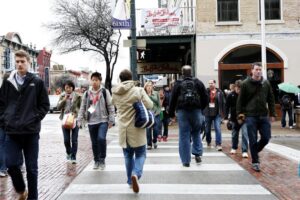In Austin, pedestrian accidents are a significant concern, underscoring the need for heightened awareness and safety measures. Knowing the common locations where these accidents occur can prevent accidents between pedestrians and motorists. From bustling downtown intersections and residential areas to commercial districts, the risk is diverse. This overview will shed light on the prevalent locations, emphasizing the importance of vigilance and adherence to safety protocols to reduce the incidence of Austin pedestrian accidents in the city. In case of a pedestrian accident, reach out to Austin pedestrian accident lawyers for assistance—ensuring you and your loved ones receive the support you deserve.
Austin Pedestrian Accidents by the Numbers
According to the Texas Department of Transportation (TxDOT), pedestrian traffic fatalities account for one in five of all roadway deaths. In its most recent reporting period, 5,764 crashes involved pedestrians in Texas, resulting in 829 deaths. Another 1,526 people were seriously injured. In the last five years, pedestrian traffic deaths have increased 29.6 percent statewide. According to its Pedestrian Safety Action Plan, in the greater Austin area, TxDOT recorded 2,335 pedestrian crashes in a four-year period, accounting for 8 percent of statewide crashes. There were 260 pedestrian fatalities and 491 serious pedestrian injuries. Vulnerable populations include children aged 16 and younger, who account for 11 percent of those involved in pedestrian crashes, and people aged 65 or older, who account for 8 percent of the total.- Interstate 35 in Travis County (130 crashes)
- State Loop 275 (North Lamar) in Travis County (55 crashes)
- State Loop 343 (South Lamar) in Travis County (47 crashes)
- S Congress Ave in Travis County (26 crashes)
- State Highway 71 in Travis County (26 crashes)
KAB is shorthand for the functional measure of the injury severity for any person involved in the crash. K = Fatal Injury, A = Suspected Serious Injury, and B = Suspected Minor Injury.
Downtown Austin
Downtown Austin serves as a focal point for both residents and visitors, but it also poses specific challenges regarding pedestrian safety. Vision Zero is an organization working to reduce people hurt or killed by traffic crashes in Austin to zero. Vision Zero reports that over 12 percent of all pedestrian crashes in Austin occur downtown, despite downtown making up less than 1 percent of the city’s street network. Similarly, downtown accounts for more than 22 percent of pedestrian crashes involving left-turning vehicles. Downtown's bustling intersections and crosswalks demand heightened caution. The convergence of vehicular and pedestrian traffic creates a dynamic environment where accidents can occur. Drivers must pay close attention in these areas, adhering to traffic signals and designated crosswalks to mitigate the risk of collisions. The proximity of popular attractions in downtown Austin naturally draws significant pedestrian traffic. Whether it's near entertainment venues, cultural sites, or business hubs, the mix of locals and tourists necessitates careful navigation. Both pedestrians and drivers should anticipate increased foot traffic, adhere to speed limits, and exercise patience to ensure safety.Residential Areas and Pedestrian Accident Risk
Residential areas in Austin present unique challenges for pedestrian safety, requiring a keen understanding of potential risk factors. Proximity to schools and parks in residential zones increases the likelihood of pedestrian activity, especially during school hours and recreational periods. Drivers must exercise caution, adhere to reduced speed limits, and be vigilant for children and families crossing streets. Pedestrians, in turn, should use marked crosswalks and follow established safety guidelines to mitigate the risks associated with increased foot traffic near these community focal points. Uneven sidewalks, obscured crosswalks, and unexpected turns by drivers can also contribute to accidents in residential areas. Ensuring well-maintained sidewalks and clear signage enhances safety for those navigating these local streets.Pedestrian Crashes in Commercial Districts
Pedestrian safety in commercial areas of Austin requires a nuanced approach due to the distinctive challenges posed by shopping areas, parking lots, and business zones. Shopping districts are prime locations for pedestrians and vehicles to meet, creating potential hazards. Parking lots, in particular, can be high-risk zones.
Drivers should exercise caution, adhere to speed limits, and remain vigilant for pedestrians navigating these spaces. Pedestrians, on the other hand, should use designated walkways and walk carefully in parking lots to reduce the risk of accidents.
Business zones with high vehicular activity present potential dangers. The ebb and flow of traffic in these areas requires strict adherence to traffic signals and designated crosswalks.
Drivers must watch for foot traffic, especially in areas with storefronts and restaurants. Clear signage and proper infrastructure play a vital role in ensuring the safety of both pedestrians and drivers in these bustling commercial zones.
Shopping districts are prime locations for pedestrians and vehicles to meet, creating potential hazards. Parking lots, in particular, can be high-risk zones.
Drivers should exercise caution, adhere to speed limits, and remain vigilant for pedestrians navigating these spaces. Pedestrians, on the other hand, should use designated walkways and walk carefully in parking lots to reduce the risk of accidents.
Business zones with high vehicular activity present potential dangers. The ebb and flow of traffic in these areas requires strict adherence to traffic signals and designated crosswalks.
Drivers must watch for foot traffic, especially in areas with storefronts and restaurants. Clear signage and proper infrastructure play a vital role in ensuring the safety of both pedestrians and drivers in these bustling commercial zones.
Common Types of Austin Pedestrian Accidents
Pedestrian accidents can take various forms, each presenting unique challenges and risks. Common Austin pedestrian accidents include:- Right Turns at Intersections: Pedestrians are particularly vulnerable when a vehicle turns right at an intersection. Drivers may focus more on oncoming traffic from the left than on pedestrians crossing the street.
- Left Turns at Intersections: Pedestrians crossing at intersections can be at risk from vehicles making left turns. The turning vehicle may not always yield the right of way to pedestrians in the crosswalk.
- Crosswalk Encounters: Even in designated crosswalks, pedestrians can be in danger when vehicles make turns without checking for people on foot. This is especially true in areas with high foot traffic.
- Complex Traffic Scenarios: In busy urban environments, turning vehicles navigate through complex traffic situations. Pedestrians must be cautious when crossing streets, even if they have the right of way, as turning vehicles may not always yield as expected.
- Backover Accidents: Pedestrians are at risk of being struck by a vehicle moving backward, often in parking lots or driveways.
- Sidewalk Accidents: Vehicles that veer onto sidewalks, especially in busy urban areas, may hit pedestrians.
- Parking Lot Incidents: Collisions occur in parking lots due to the mix of pedestrians and vehicles.
- Distracted Walking Accidents: Pedestrians engrossed in smartphones or other distractions may not notice oncoming traffic.
Legal Considerations for Victims of Pedestrian Accidents
Addressing legal considerations for victims of Austin pedestrian accidents involves understanding both the rights and responsibilities of pedestrians and the potential avenues for seeking legal recourse after an incident.Rights and Responsibilities of Pedestrians
- Right of Way: Pedestrians generally have the right of way in crosswalks and at intersections.
- Sidewalk Usage: Pedestrians have the right to use sidewalks and should not be put in danger by vehicles leaving or entering roadways.
- Crosswalk Safety: Pedestrians must use crosswalks when available and obey traffic signals.
- Responsibility for Safety: While pedestrians have rights, they also bear a responsibility to exercise reasonable care for their safety, such as avoiding distractions and crossing streets with caution.
What to Do After an Accident
- Document the Scene: Collect evidence, take photos, and gather witness statements if possible.
- Medical Attention: Seek medical attention promptly, even for seemingly minor injuries.
- File a Police Report: Report the accident to law enforcement, providing an accurate account of what happened.
- Preserve Evidence: Keep records of medical bills, photos, and any other evidence related to the accident.
- Legal Consultation: Consult an attorney experienced in personal injury law to understand options for legal recourse.
Potential Damages Available for a Pedestrian Crash Injury
After a traffic crash causes a pedestrian injury, compensation may cover medical expenses, including current and future treatment costs, rehabilitation, and any necessary assistive devices. Additionally, victims may seek compensation for lost wages due to the inability to work during recovery. Damages can also pay for pain and suffering, emotional distress, and diminished quality of life. Seeking legal advice from an experienced personal injury attorney can help pedestrians understand their rights and pursue just compensation for the physical, emotional, and financial impacts of the accident.Contact Lorenz & Lorenz Accident & Injury Lawyers PLLC
If you or a loved one suffered injuries or wrongful death as a result of a pedestrian traffic crash, don't face the legal complexities alone. At Lorenz & Lorenz Accident & Injury Lawyers PLLC, we are committed to advocating for your rights and securing the compensation you deserve. Our experienced team understands the challenges associated with Austin pedestrian accidents and is ready to provide compassionate and professional legal support.
